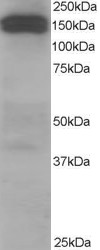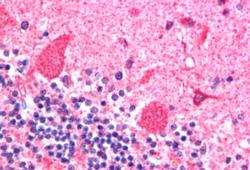Goat Anti-Dynactin Antibody
Peptide-affinity purified goat antibody
- SPECIFICATION
- CITATIONS
- PROTOCOLS
- BACKGROUND

Application
| WB, IHC, ICC, E |
|---|---|
| Primary Accession | Q14203 |
| Other Accession | NP_001128513, 1639, 13191 (mouse) |
| Reactivity | Human, Mouse |
| Predicted | Rat |
| Host | Goat |
| Clonality | Polyclonal |
| Concentration | 0.5 mg/ml |
| Isotype | IgG |
| Calculated MW | 141695 Da |
| Gene ID | 1639 |
|---|---|
| Other Names | Dynactin subunit 1, 150 kDa dynein-associated polypeptide, DAP-150, DP-150, p135, p150-glued, DCTN1 |
| Format | 0.5 mg IgG/ml in Tris saline (20mM Tris pH7.3, 150mM NaCl), 0.02% sodium azide, with 0.5% bovine serum albumin |
| Storage | Maintain refrigerated at 2-8°C for up to 6 months. For long term storage store at -20°C in small aliquots to prevent freeze-thaw cycles. |
| Precautions | Goat Anti-Dynactin Antibody is for research use only and not for use in diagnostic or therapeutic procedures. |
| Name | DCTN1 (HGNC:2711) |
|---|---|
| Function | Part of the dynactin complex that activates the molecular motor dynein for ultra-processive transport along microtubules (By similarity). Plays a key role in dynein-mediated retrograde transport of vesicles and organelles along microtubules by recruiting and tethering dynein to microtubules. Binds to both dynein and microtubules providing a link between specific cargos, microtubules and dynein. Essential for targeting dynein to microtubule plus ends, recruiting dynein to membranous cargos and enhancing dynein processivity (the ability to move along a microtubule for a long distance without falling off the track). Can also act as a brake to slow the dynein motor during motility along the microtubule (PubMed:25185702). Can regulate microtubule stability by promoting microtubule formation, nucleation and polymerization and by inhibiting microtubule catastrophe in neurons. Inhibits microtubule catastrophe by binding both to microtubules and to tubulin, leading to enhanced microtubule stability along the axon (PubMed:23874158). Plays a role in metaphase spindle orientation (PubMed:22327364). Plays a role in centriole cohesion and subdistal appendage organization and function. Its recruitment to the centriole in a KIF3A-dependent manner is essential for the maintenance of centriole cohesion and the formation of subdistal appendage. Also required for microtubule anchoring at the mother centriole (PubMed:23386061). Plays a role in primary cilia formation (PubMed:25774020). |
| Cellular Location | Cytoplasm. Cytoplasm, cytoskeleton. Cytoplasm, cytoskeleton, microtubule organizing center, centrosome. Cytoplasm, cytoskeleton, microtubule organizing center, centrosome, centriole. Cytoplasm, cytoskeleton, spindle. Nucleus envelope. Cytoplasm, cell cortex. Note=Localizes to microtubule plus ends (PubMed:17828277, PubMed:22777741, PubMed:25774020). Localizes preferentially to the ends of tyrosinated microtubules (PubMed:26972003). Localization at centrosome is regulated by SLK- dependent phosphorylation (PubMed:23985322). Localizes to centrosome in a PARKDA-dependent manner (PubMed:20719959). Localizes to the subdistal appendage region of the centriole in a KIF3A-dependent manner (PubMed:23386061). PLK1-mediated phosphorylation at Ser-179 is essential for its localization in the nuclear envelope (PubMed:20679239). |
| Tissue Location | Brain. |

Thousands of laboratories across the world have published research that depended on the performance of antibodies from Abcepta to advance their research. Check out links to articles that cite our products in major peer-reviewed journals, organized by research category.
info@abcepta.com, and receive a free "I Love Antibodies" mug.
Provided below are standard protocols that you may find useful for product applications.
Background
This gene encodes the largest subunit of dynactin, a macromolecular complex consisting of 10 subunits ranging in size from 22 to 150 kD. Dynactin binds to both microtubules and cytoplasmic dynein. Dynactin is involved in a diverse array of cellular functions, including ER-to-Golgi transport, the centripetal movement of lysosomes and endosomes, spindle formation, chromosome movement, nuclear positioning, and axonogenesis. This subunit interacts with dynein intermediate chain by its domains directly binding to dynein and binds to microtubules via a highly conserved glycine-rich cytoskeleton-associated protein (CAP-Gly) domain in its N-terminus. Alternative splicing of this gene results in multiple transcript variants encoding distinct isoforms. Mutations in this gene cause distal hereditary motor neuronopathy type VIIB (HMN7B) which is also known as distal spinal and bulbar muscular atrophy (dSBMA).
References
Disease-associated mutations in the p150(Glued) subunit destabilize the CAP-gly domain. Ahmed S, et al. Biochemistry, 2010 Jun 29. PMID 20518521.
Centrosome-related genes, genetic variation, and risk of breast cancer. Olson JE, et al. Breast Cancer Res Treat, 2010 May 28. PMID 20508983.
The retromer component SNX6 interacts with dynactin p150(Glued) and mediates endosome-to-TGN transport. Hong Z, et al. Cell Res, 2009 Dec. PMID 19935774.
Dynactin subunit p150Glued isoforms notable for differential interaction with microtubules. Zhapparova ON, et al. Traffic, 2009 Nov. PMID 19778315.
Cholesterol sensor ORP1L contacts the ER protein VAP to control Rab7-RILP-p150 Glued and late endosome positioning. Rocha N, et al. J Cell Biol, 2009 Jun 29. PMID 19564404.
If you have used an Abcepta product and would like to share how it has performed, please click on the "Submit Review" button and provide the requested information. Our staff will examine and post your review and contact you if needed.
If you have any additional inquiries please email technical services at tech@abcepta.com.













 Foundational characteristics of cancer include proliferation, angiogenesis, migration, evasion of apoptosis, and cellular immortality. Find key markers for these cellular processes and antibodies to detect them.
Foundational characteristics of cancer include proliferation, angiogenesis, migration, evasion of apoptosis, and cellular immortality. Find key markers for these cellular processes and antibodies to detect them. The SUMOplot™ Analysis Program predicts and scores sumoylation sites in your protein. SUMOylation is a post-translational modification involved in various cellular processes, such as nuclear-cytosolic transport, transcriptional regulation, apoptosis, protein stability, response to stress, and progression through the cell cycle.
The SUMOplot™ Analysis Program predicts and scores sumoylation sites in your protein. SUMOylation is a post-translational modification involved in various cellular processes, such as nuclear-cytosolic transport, transcriptional regulation, apoptosis, protein stability, response to stress, and progression through the cell cycle. The Autophagy Receptor Motif Plotter predicts and scores autophagy receptor binding sites in your protein. Identifying proteins connected to this pathway is critical to understanding the role of autophagy in physiological as well as pathological processes such as development, differentiation, neurodegenerative diseases, stress, infection, and cancer.
The Autophagy Receptor Motif Plotter predicts and scores autophagy receptor binding sites in your protein. Identifying proteins connected to this pathway is critical to understanding the role of autophagy in physiological as well as pathological processes such as development, differentiation, neurodegenerative diseases, stress, infection, and cancer.



